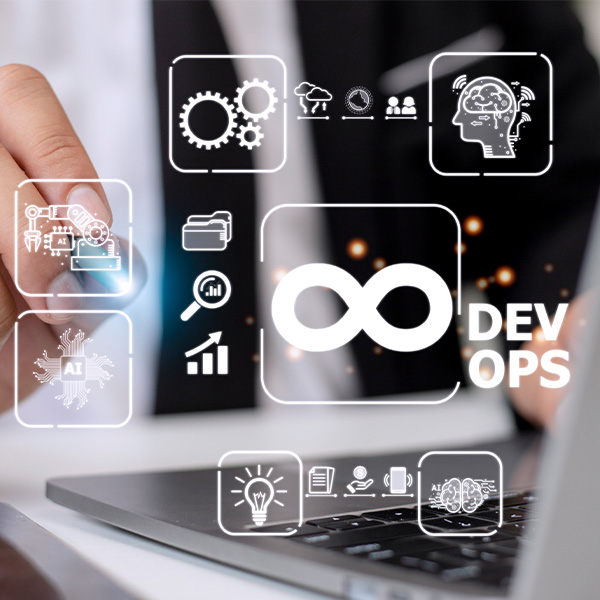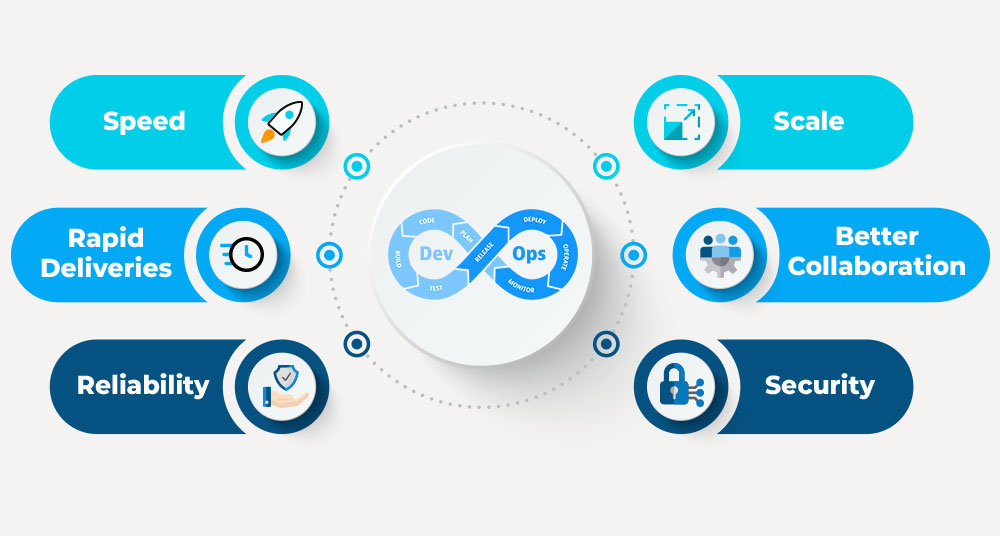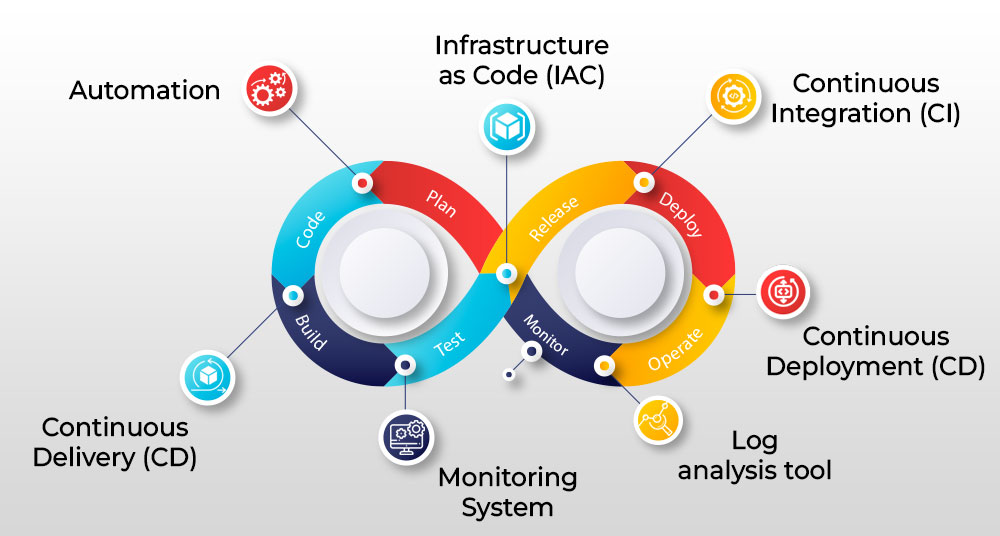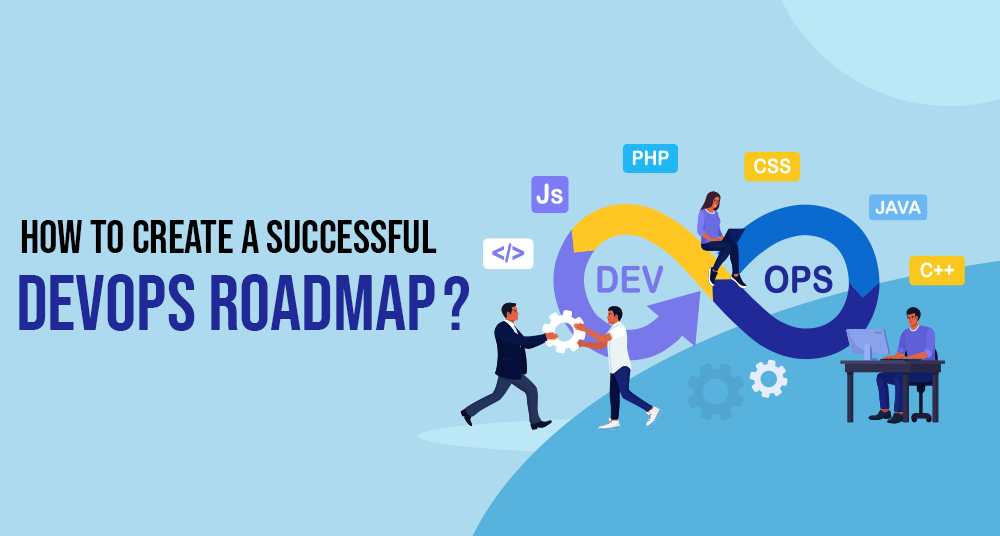Introduction
DevOps implementation in your company in 2025 is surely a must! In this article, we will cover how to successfully create a DevOps Roadmap for your software development company in 2025? With this guide, you will be able to successfully leverage the key phases of your project and find the best software development services.
What is DevOps?

DevOps is a combination of tools, practices, and cultural philosophy that expands an organization’s potential to deliver apps and services at a higher velocity. DevOps increases the speed, efficiency, and security of software development by combining operations and development which results in an advantage for businesses and other enterprises. DevOps, a combination of development (dev) and operations (ops) enables software development and allows teams to accelerate delivery through collaboration, automation, faster feedback, and constant improvement.
Basics of DevOps
DevOps is an approach to enhance the field of software development that combines IT operations and developers and aims to automate processes within the IT sector. By integrating tools from both of these departments, DevOps through the help of technology enables continuous delivery and deployment and further helps improve efficiency. DevOps and Continuous delivery (CD) or Continuous Integration (CI) are similar concepts but they are not the same thing. Since CI requires integration of different parts of a company, it requires more time, and CD through the use of automation builds and deploys applications, and automates testing.
Benefits of DevOps

- Speed- DevOps model moves at a higher velocity so you can innovate for your customers and adapt to the changing market efficiently as well as drive better business results.
- Rapid deliveries- Through the use of DevOps, you can increase the frequency and pace of your releases. It allows you to fix bugs instantly and introduce newer versions of the software by responding to your customer needs quickly and building a competitive advantage.
- Reliability- To maintain a consistent positive experience for your customers, you must ensure that the quality of application updates and any other infrastructure changes are delivered at a rapid pace.
- Scale- DevOps helps manage and operate your development processes at scale. Complex and changing systems can be managed by automation and consistency with minimal risk.
- Better Collaboration- Under a cultural DevOps model, more effective teams can be built that emphasize the value of accountability and ownership. Developers and operational teams share the ability to collaborate closely, divide responsibilities, and combine their workflows. It helps save time and reduces inefficiencies.
- Security- A DevOps model can be adopted without comprising security through the use of automated compliance policies, configuration management techniques, and fine-grained controls
Additional benefits
- Refined software quality.
- Greater IT efficiency.
- Efficient organizational responsiveness.
- Better customer service.
- Less chances of business disruption.
- Accurate financial predictions.
- Team morale and productivity is at a boost.
- Reduction in problems caused due to human error.
- Decreased costs of ownership.
Why DevOps Matters
The Internet and software development together have transformed the technological world and all its industries ranging from shopping to banking. Not only does software support a business, it has become a very integral part of it. Constant software development has made it easier for companies to interact with their customers with the use of online services or applications available on all types of devices. Software is also used to increase operational efficiency as it transfers every part of the value chain including logistics, operations, and communications. DevOps has helped companies transform the way they build, design, and deliver products through the use of industrial automation.
How to adopt a DevOps model? (Cultural philosophy)
A change in culture and mindset is required to transition to DevOps. This transition helps remove barriers between two traditionally connected teams, development, and operations. In some organizations, these two departments don’t even have separate wings. With the use of DevOps, these teams work together to optimize and gain maximum productivity of developers and reliable operations. It has helped them communicate frequently, decrease inefficiencies, and improve the quality of services provided to customers. Organizations that use a DevOps model, regardless of their infrastructure have teams available to supervise the entire development process and lifecycle as part of their jobs.
Challenges faced during the implementation of DevOps
Managing change is one of the biggest challenges faced during the implementation of DevOps. Change management can be difficult as it is a systematic approach and requires a lot of time and intellect to understand the areas that need change, how these changes will be made, who will be responsible for making these changes, and how they will be communicated to the people concerned. To implement DevOps successfully, senior leadership should be put in charge. Everyone must be given responsibility for a specified part of the organization which they are supposed to carry out smoothly.
Other challenges
- Finding the target audience.
- Acquiring buy-in offers from management and team members.
- Incorporating the use of new tools into the process of development and training employees on how to use them correctly.
- Educating employees about accomplishments that are set to be achieved and how to work together in order to achieve them in the most efficient way.
Common terms used in DevOps

- Automation- When your team instantly needs to make changes but does not have a well-experienced coder, automation comes in handy. It removes the need for users to have extensive knowledge regarding coding as well as programming experience. Non-technical users have the ability to configure tasks in order to automate common processes like app deployment and upgrading servers via text file configurations.
- Infrastructure as Code (IAC)- IAC refers to maintaining and provisioning infrastructure through code in place of manual labor. It helps allocate resources correctly and also provides a blueprint of services that are available for other developers present on the team.
- Continuous Integration (CI)- Continuous Integration is the process of the integration of all developer codes with a shared depository many times a day automatic tests are run opposite merged codes that help analyze problems early in the cycle of development.
- Continuous Delivery (CD)- Continuous Delivery refers to the process of automated testing, deployment, and approval processes so that new features can be effectively released into production.
- Continuous Deployment (CD)- Continuous Deployment automatically deploys updates without the need for any human intervention.
- Monitoring System- A monitoring system is very beneficial for development teams as it allows them to have clear visibility into their systems including the usage of CPU, network latency, and disk usage.
- Log analysis tool- Another critical component in the stack of technology.
DevOps Implementation Roadmap:-
- A Continuous delivery pipeline:- The implementation of a continuous delivery pipeline provides the ability to deploy updates automatically to your application by the use of a combination of automated tests and an infrastructure that depending on the load on the system can be scaled up or down. Continuous integration or deployment (CI/CD) is another name for this pipeline. It removes the need for human intervention and helps save time making the process more efficient. A few challenges are faced while implementing a continuous delivery pipeline. One such challenge is your cloud resources must be scaled according to the demand presented on them at any given time. It can also lead to resources being under-utilized with no provisions for reducing costs as they are not running throughout the day. Server-less architecture meets the scale of resources according to the demand presented automatically, thus with the use of server-less architecture, this problem can be solved.
- Service Discovery Automation:- It is a game-changing technology that contributes towards making your organization secure, efficient, and agile and it does so by the automation of all service discovery tasks. With the use of SDA, you discover and connect to services as well as continuous integration processes by a single source. SDAs also offer an outstanding comprehensive set of innovative capabilities that strengthen your IT team with tools to quickly react to business demands.
- Implementation of Micro-services Architecture:- In order to successfully implement Micro-services Architecture and use it to its full potential, you need to use Partner API. Partner APIs are a set of Micro-services designed specifically for interoperability. Each API works with others as long as they have the same standards. For APIs to work together, they must conform to the same standards.
- Building a CI pipeline:- CI build jobs must be established to build a CI pipeline. These jobs reduce the workload by taking the code from Git, compiling it, and running all unit tests. A new build is created and automatically deployed every time a commit is pushed. This process further removes the need for any manual intervention.
- Build alerting into the CI/CD pipeline:- One of the critical components of CI/CD pipelines is alerting. It notifies the team members of any failures that may have occurred or any other deviations or issues from the desired state. Alerts should be configured to go out through email, PagerDuty, or any other monitoring tools.
- Gain visibility into Application lifestyle:- Any successful DevOps implementation requires Data as its cornerstone. All modern applications are mostly data-driven and in order to gain visibility into data that is being generated by your application, you require a holistic approach. This provides better insights into the data being produced by your app and you are able to monitor any and all problems as they arise and fix them efficiently. To get these insights, you must invest in monitoring infrastructure and solutions that offer more comprehensive management capabilities. While choosing the correct monitoring tools to use at each phase of the application development process, start with a solution that is the baseline for analyzing the performance at scale during the process.
- DevOps culture:- One of the very crucial aspects of the DevOps implementation model is culture. Culture comprises shared norms and values between members of a team that govern the interactions among managers, employees, and customers. In order for a company to successfully adopt DevOps practices it to be most effective, they must understand the current culture before making any changes or improvements as cultural values might inhibit the adoption of these practices. The companies interested in adopting DevOps practices must look at (i) efficiency of operations, (ii) quality, (iii) customer support, and (iv) organizational agility. All these elements together contribute to the overall success of a company.
- Containerizing components:- Operations professionals and developers must understand how to leverage container technology in order to make their jobs easier. While designing an implementation roadmap of DevOps, you must consider containerizing your components. All of the application code is stored in the container, they are lightweight as they share the host system’s kernel. Containerization has made it easy to run one or more containers on a single host operating system without the worry of OS licensing costs or additional hardware. Using containers for the implementation of DevOps has proved to be very beneficial as it saves time by simplifying deployments and speeds up the testing cycle to make the management of infrastructure simpler and improves systematic reliability.
- Determine which applications can be containerized:- In order to determine which applications can be containerized, you must identify the consistent and predictable running time of those applications in order for them to be packaged. You can do so by identifying the libraries it uses and if that isn’t enough you can also install the application on an isolated machine and run it through some tests.
Conclusion
To incorporate the usage of the DevOps model and to implement it successfully, you need to hire software developers in India. You need to have a clear knowledge about the services that they offer and you need to have a competitive compensation package to offer them. You must also have an understanding of the current needs of your company so that the software developers can identify the areas in which it needs to excel. In this way, you can use the DevOps model to its full potential and hire the best software developers available in India.






What do you think?
It is nice to know your opinion. Leave a comment.